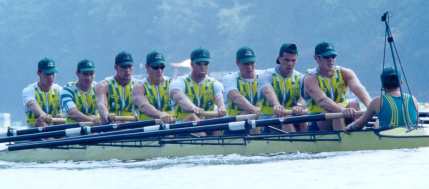|

|
ICE JACKETS ARE
COOL
David
T Martin, Allan G
Hahn, Rebecca Ryan-Tanner, Kelly Yates, Hamilton Lee, John A
Smith, Department of Physiology and Applied Nutrition,
Australian Institute of Sport, Belconnen, Australia.
Sportscience News Nov-Dec 1998
http://www.sportsci.org/news/news9811/AISjackets.html
|
|
|
|
Scientists at the Australian
Institute of Sport have developed a jacket for pre-cooling
athletes before endurance events in the heat. The jackets
are made from wet-suit material and are packed with ice.
Athletes who wore the jackets at the Atlanta Olympics
probably boosted their output power by 1-2%.
|

Olympian wearing an AIS ice
jacket
|
Hot or humid environmental conditions have a negative effect
on endurance performance (e.g., Galloway and
Maughan, 1997). Any strategies that delay or reduce the increase
in body temperature during exercise are therefore likely to enhance
performance in the heat. In this article we summarize research on the
effectiveness of one of these strategies, pre-event cooling. We also
discuss a series of studies completed at the
Australian Institute of Sport (AIS) that led to the
development of a cooling jacket subsequently used by many Australian
Olympians during the 1996 Summer Olympic Games in Atlanta.
Research on Pre-cooling
The concept of reducing skin or core temperature prior to
endurance competition has been investigated since the early 1980s
(see review by Booth et al., 1997). Lower skin
temperatures enable a greater temperature gradient for dissipating
heat from deeper regions of the body (Schmidt et
al., 1981). Cooler skin temperatures mean that less of the total
cardiac output is directed toward the skin, possibly allowing more
blood to be directed to active skeletal muscle. Lower skin and core
temperatures can also delay the onset of sweating and decrease sweat
rate, resulting in a conservation of body water during a prolonged
competitive event (Hessermer et al., 1984).
The following published papers form the basis for the current
pre-cooling practices used by athletes prior to competition in the
heat.
Schmidt and Brück (1981) decreased
core temperature by 1ºC in 12 well-trained rowers and observed
that the heart rate and sweat rate response to a progressive maximal
test was reduced in the pre-cooled versus the control trial. In this
study all subjects rested at 28ºC for 30 min prior to the
bicycle test that was performed at 18ºC. Pre-cooling did not
affect maximum oxygen uptake (VO2max) or peak
power output.
Hessermer et al. (1984) used a similar
design but incorporated a 60-min maximal cycling time trial for their
performance test. The eight well-trained rowers improved their
average power output by 6.8% when the 60-min time trial was preceded
by a cold air pre-cooling maneuver that decreased mean skin
temperature by 4.5ºC.
Myler, Hahn & Tumilty (1989) investigated
the effects of pre-cooling on the ability of rowers to perform at
30ºC and 30% humidity. They found that performance of a 6-min
maximal rowing effort improved significantly: after 5 min of icing
the skin, the rowers traveled 17 meters further in a 6-min all-out
rowing test. The increase in power output averaged ~3%.
Lee and Haymes (1995) observed improvements in
running performance following a pre-cooling procedure. Fourteen
physically fit male runners were pre-cooled for 30 min using cold
air. After a 10-min transition period, during which skin temperatures
were allowed to warm, subjects ran until exhaustion at 82% VO2max at 24°C. Pre-cooling caused a 0.37°C
drop in core temperature and an improvement in running time from 22.4
to 26.2 min, or 17%. (equivalent to about 1% in an event). The
improved performance was associated with a decreased sweat rate.
Booth et al. (1997) cooled their subjects by
about 0.5ºC using a 20-min cold-water bath. In a subsequent
30-min maximal running test in hot humid conditions (32ºC, 62%
humidity), maximal 30-min run distance increased by about 2%.
Development of AIS Ice Jackets
Impressed by the potential benefits of pre-cooling on performance,
scientists at the Australian Institute of Sport designed a cooling
jacket for their athletes. The jacket was made from wet-suit material
(Neoprene) and was designed to be packed with ice. In 1996 six women
cyclists who were members of the Australian National road cycling
squad agreed to use the prototype prior to a 25-km individual time
trial held in Queensland, Australia. Not surprisingly, the cyclists
felt noticeably cooler and upper chest skin temperature was reduced
immediately following removal of the jacket. After the race the
cyclists documented their impressions of the ice jacket by completing
a questionnaire. Their suggestions were used to modify the jacket for
the next prototype.
In collaboration with the Commonwealth Scientific and Industrial
Research Organization and the University of Sydney, the AIS next
recruited nine recreational cyclists to complete maximal graded
exercise tests on a bicycle ergometer in a heat chamber at 32ºC
and 60% humidity. The first trial was used to familiarize the
subjects to the testing procedure. Subjects then completed either a
cooling trial or a control trial in a cross-over fashion. For the
cooling trial the modified cooling jacket was worn for the first 9
min of the protocol (125-175 watts). Subjects cycled for an average
of 1.1 min longer during the cooling trial (332 vs 341 watts).
Thermocouples attached to the mid-chest and the mid-back indicated
that the skin temperature beneath the cooling jacket decreased from
32-35ºC down to 10-16ºC by the end of the 9-min period.
During the cooling trial perception of effort and perception of
thermal comfort was significantly improved. Despite these differences
in perceptions and skin temperature, the ice jacket did not affect
rectal temperature, heart rate, or blood lactate
(Smith et al., 1997).
For the next study, four female and seven male rowers from the
Australian Defense Force Academy completed two maximal 2000-m
laboratory trials on a Concept IIb rowing ergometer in the AIS
environmental chamber (33ºC, 60% humidity). Prior to the 2000-m
trials, rowers consumed 350 ml of water and completed a 30-min
warm-up at 75% of the power output achieved during a maximal effort
familiarization trial. Prior to the start of the maximal exercise, an
extra 150 ml of water was consumed. For the pre-cooling trial, a
final version Neoprene cooling jacket developed by Neptune Wetsuits
was worn throughout the warm-up period and the rowers were informed
they were drinking water. For the placebo trial red food coloring was
added to the water and rowers were told they were receiving glycerol,
an agent that could aid in hydration and improve performance.
Following pre-cooling, average rowing times decreased by 2.8 seconds,
or 1.2%. In the cooling jacket trial there was less of an increase in
core temperature and lower sweat rates during the warm-up. Following
the warm-up period, rowers rated their thermal comfort significantly
better in the pre-cooling trial, and this improved thermal comfort
was also apparent following the 2000-m rowing test. Similarly, the
perceived exertion following the rowing test was significantly lower,
despite an elevated post exercise blood lactate and a lower blood pH.
The success of pre-cooling suggests that the duration and the
intensity of a warm-up should be limited so that core temperature is
not elevated prior to competition. One of the primary advantages of a
cooling jacket may be that this form of active cooling allows an
athlete to experience competition-specific exercise intensity during
the warm-up without causing a substantial increase in core
temperature.
AIS Jackets at the 1996
Olympics
Feedback from coaches, athletes and sport scientists was
incorporated into the Olympic version of the cooling jacket for
Australian athletes. It was left up to each sport to evaluate rules
to ensure that the ice jacket would not be considered illegal prior
to Olympic competition. The proper contacts were made and both Adidas
(official Olympic clothing sponsor for Australia) and the Australian
Olympic Committee agreed to support the use of the ice jacket by
Australian Olympians. Once the administrative aspects of the project
were in order Olympic ice jackets were sent out to track cycling,
mountain cycling, road cycling, rowing, canoeing, hockey, and track
and field. Each sport then refined the pre-cooling protocols for use
prior to Olympic competition.
Approximately 200 green and gold ice jackets bearing the
Australian coat of arms were produced for Olympic athletes traveling
to Atlanta. Another 30-40 jackets were produced for Australian
athletes competing in the Para-Olympic Games. In all cases athletes
were not forced to use the ice jackets. Instead, athletes were made
aware of laboratory data indicating the potential for beneficial
effects and then the use of ice jackets was incorporated into
practice sessions. Quite simply, many athletes liked the way the
jackets felt when training and competing in hot conditions.
Evaluation sheets were returned by 43 Olympic athletes and 7
Olympic coaches who used the cooling jackets in Atlanta. Athletes and
coaches represented road cycling, mountain cycling, rowing, field
hockey, and track and field (mostly race walkers). Preliminary data
indicate that 90% of the respondents used the cooling jackets during
training sessions and 80% used the cooling jackets as an aid during
Olympic competition. All athletes who used a cooling jacket during
competition indicated that it made a positive contribution to their
performance. Taking into account these comments and previous
research, we believe that the jackets enhanced the output power of
our athletes by at least a percent or two, depending on the event and
the extent of pre-cooling. Ice jackets will be used increasingly in
competitions held under hot conditions.

Australian rowing team wearing jackets
at Atlanta in 1996
References
Booth, J., Marino, F. & Ward, J.J. (1997).
Improved running performance in hot humid conditions following whole
body pre-cooling. Medicine and Science in Sports and Exercise, 29,
943-949.
Galloway, S.D.R. & Maughan, R.J.
(1997). Effects of ambient temperature on the capacity to perform
prolonged cycle exercise in man. Medicine and Science in Sports and
Exercise, 29, 1240-1249.
Hessermer, V., Langusch, D., Brück,
K., Bödeker, R.H. & Breidenbach, T. (1984). Effect of
slightly lowered body temperatures on endurance performance in
humans. Journal of Applied Physiology, 57, 1731-1737.
Lee, D.T. & Haymes, E.M. (1995 ). Exercise
duration and thermoregulation responses following whole body
precooling. Journal of Applied Physiology, 79, 1971-1976.
Myler, G.R., Hahn, A.G., & Tumilty, D.M.
(1989). The effect of preliminary skin cooling on performance of
rowers in hot conditions. Excel, 6,17-21.
Schmidt, V., & Brück, K. (1981).
Effect of a pre-cooling maneuver on body temperature and exercise
performance. Journal of Applied Physiology, 50, 772-778.
Smith, J. A., Yate, K., Lee, H., Thompon,
M.W., Holcombe, B.V., & Martin, D.T. (1997). Pre-cooling improves
cycling performance in hot/humid conditions. Medicine and Science in
Sports and Exercise, 29(5), S263 (Abstract).
newseditor=AT=sportsci.org · webmaster=AT=sportsci.org · Homepage ·
©1998
Edited by Anthony Hackney and Will
Hopkins
Webmastered by Mary Ann Wallace
Last updated 21 Nov 1998

